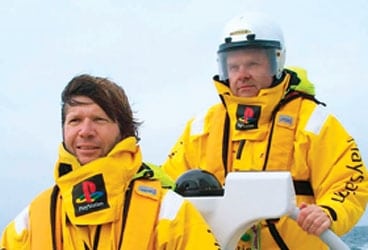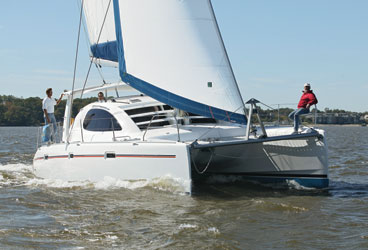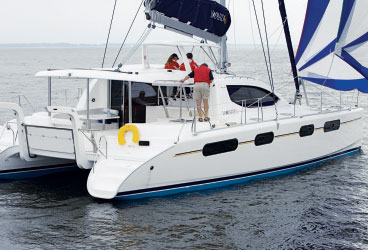
Gino368
Gino Morelli came to catamaran design as a builder of racing cats, but in recent years has brought his knowledge of performance and technology to the art of designing production cats, notably the new models for Leopard Catamarans, built in South Africa by Robertson and Caine.
How long have you been designing multihulls?
While I was in high school, my family built a 33-foot Crowther trimaran in the backyard, and we raced it in local Southern California races. I really got bitten by the boatbuilding bug when my brother and I got into racing 18-Square-Meters [catamarans] and we built our own boats. I was 20 when I sold my first boat, and we ended up building 30 of those cats. I dropped out of community college and from there I was kind of like an actor, going from performance to performance. I designed a 45-foot cat that I eventually raced to Hawaii in 1987. Wind Warrior is still doing day charters on Waikiki. She was pretty advanced construction, made of Vinylester, S glass, uni skins, PVC Klegecell, and vacuum bagged. I built her when I was 24, now I’m 51.

Billy Black| |Leopard 40|
Tell me about your first Leopard Cat design, the 40.
The introduction came by way of Lex Raas, at The Moorings. I met him after I built the Formula 40 Randy Smyth sailed when he won the 1986 series in France. Lex was working for Beneteau then, knew me by reputation, and we brushed shoulders now and then in France. When Robertson and Caine was coming up to do new 40 and looking for fresh ideas, Lex suggested that John Robertson call me. The design for the 40 got started in 2003, and it won Cruising World’s Boat of the Year award in 2005.
Were you aiming for better performance than earlier Leopards?
We were looking for a lighter boat with more performance and payload capacity. We also wanted more under-wing clearance than previous boats. With the 40, R and C’s first premise was to make sure it was a good private-owner cruising boat, then adapt it to being a good charter boat [for The Moorings]. In earlier boats, they didn’t leave enough displacement in the boats to allow for full cruising payload. Cruising cats need to carry lots of water, redundancies, and spare parts, plus the dinghy and all its gear. The big brunt of R and C’s production at that time was to build charter boats, but they knew the company could grow through addressing the private market. So we started with the worst-case scenario– a full fledged cruising boat. We wanted the transoms to clear the water and we wanted to maintain under-wing clearance. We said, let’s assume the customer is going to sail this with a family around the planet; we knew we needed to design for what they were going to take on a serious live-aboard expedition.

Billy Black| |Leopard 46|
When you designed the Leopard 46 a couple years ago, what did you change from the 40 in terms of construction?
With the 46, we used a lot of same philosophy but started to try to improve interior elements; head, access, and construction to keep weight down and improve payload. The 40 was built like previous generations of Leopards, although we used lighter scantlings and different taping systems than previous generations. That way factory inventory wasn’t changed too much. But on the 46 we started introducing lighter bias materials-fewer plys, more bias in the plys, a little more carbon on the bulkheads to lighten and stiffen the structure.
Where do you take the next Leopard?
The biggest difference will be with our new 37-foot Power Cat in which we’re infusing the hull and using a much more user-friendly assembly. Before, the boats evolved from a semi-custom style build process and were built with plywood; the head module wasn’t connected to areas for and aft. In the new boats, we have modules that run bow to stern, which makes assembly process much quicker.
How much weight have you saved?
For the first 40, compared to the old 38, we took about 3,000 pounds out of that boat. So that’s about 18 to 20 percent.
Did your giant maxi cat for Steve Fossett, PlayStation, influence your hull design?
That was a different beast, but one thing we carried on was trying to increase the rocker in the hull. When light, the 40’s bow almost comes out of the water, which enables the boat to tack and jibe much more easily. We used a slightly deeper, slightly higher-aspect keel and spade rudders instead of skeg-hung rudders. That also gave the boat more maneuverability and translates to a boat with feel in the helm. Combined with lighter weight, we think that amounted to a substantial improvement over competitors as well as the previous Leopard design. With the 46 we kept pushing the envelope in that direction.
What are R and C’s strengths as a builder that have helped make the designs successful?
I’ll point out a couple of things. They have a nice collaboration with The Moorings, which sells all the Leopards exclusively, as well as their own charter boats. In the last year, along with the philosophy I mentioned, we’re trying to get out of building and more into boat-assembly business. We want things done more consistently. Gary Steinmetz, who had been the VP of production at Toyota in South Africa, started with Robertson and Caine a year ago as the managing director and is bringing his automotive assembly mindset into the top floor of management as a catalyst to help change the company. As the company grows, a new factory is in planning stages.
Another part of Gary’s new philosophy in moving from older-fashion custom-boatbuilding mindset to a newer, assembly mindset is by improving building technique. He is working toward substantially reduce waste as well as improving factory conditions, exposing workers to far lower VOCs such as Styrene.
What’s involved in shifting to infusion?
Over last the last two or three years, we set up our own R&D shop in California near our design office. In California, we learned about the process of infusion in building A-Class Cat designs, the F-18s for Performance Catamarans, plus infusing various parts for custom clients. We even infused a spare daggerboard for PlayStation. We had to learn how to design and build with infusion in mind. John Robertson visited us several times before committing to try it on the 37PC. That’s when I moved to Cape Town, for the last year. The first infused 37 we built was a Powercat, launched in May.
What are the typical configurations requested by Leopard owners and what sorts of equipment do you expect them to carry?
They almost always choose a three-cabin configuration with an owner’s hull. We have to plan for more and bigger anchors and chain, which is the best insurance you can buy for a boat. We also expect that the keels are going to take a pounding, so we build them to do that. The harsh reality of cruising is that you’re going to meet the dirt one of these days. We expect owners to have watermakers, which means the water tanks can be smaller than they would be on charter boats. Other equipment? More batteries, beefier autopilots, solar panels, SSB, weather fax, and laptops.
The typical cruiser doesn’t go out with eight people; they often use the forward port cabin as a junk room. They may simply take out the berth and build in shelving to create a tool room or workshop. The boats are so shallow in draft there’s no bilge storage; it’s all above waterline, under berths (which lift), and in cubbies. As a production builder, R and C doesn’t customize this for you, but owners can contract for an after-market modification.
We’re seeing the ratio of private owners (compared to boats built for charter) continue to grow, and in the last year 46 percent of the boats built went to private owners. That’s something I keep pushing; with the introduction of the 37PC and the new factory after that, R and C will have the capacity to go from 100 to 300 boats per year.
What can you tell us about the design of the new 38? How will this be special?
Our entry level boat brings together refined design, refined building, and a new factory process and layout. We got our toe dipped into it with the 37PC Powercat. Now our production efficiency will hopefully be on par with our biggest competitors.
You also have a 60-footer in the works. That’s a new market for Leopard. Is it designed to have a professional captain aboard?
The 60 is in the design-brief stage so it’s early to talk about it too much. We’re working out the private side design first, and, yes, most would have professional skippers.
For more on Leopard cats, visit www.leopardcatamarans.com.








